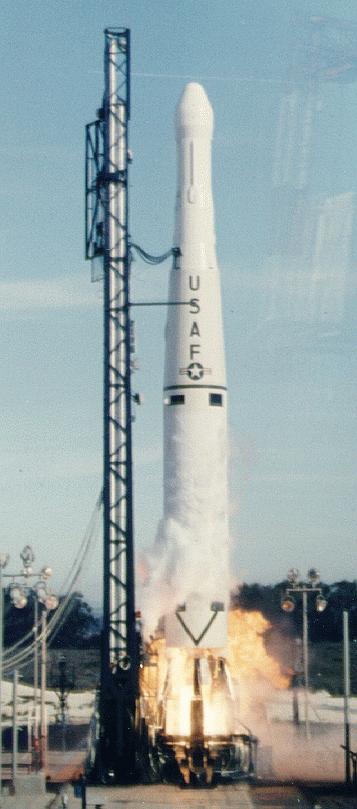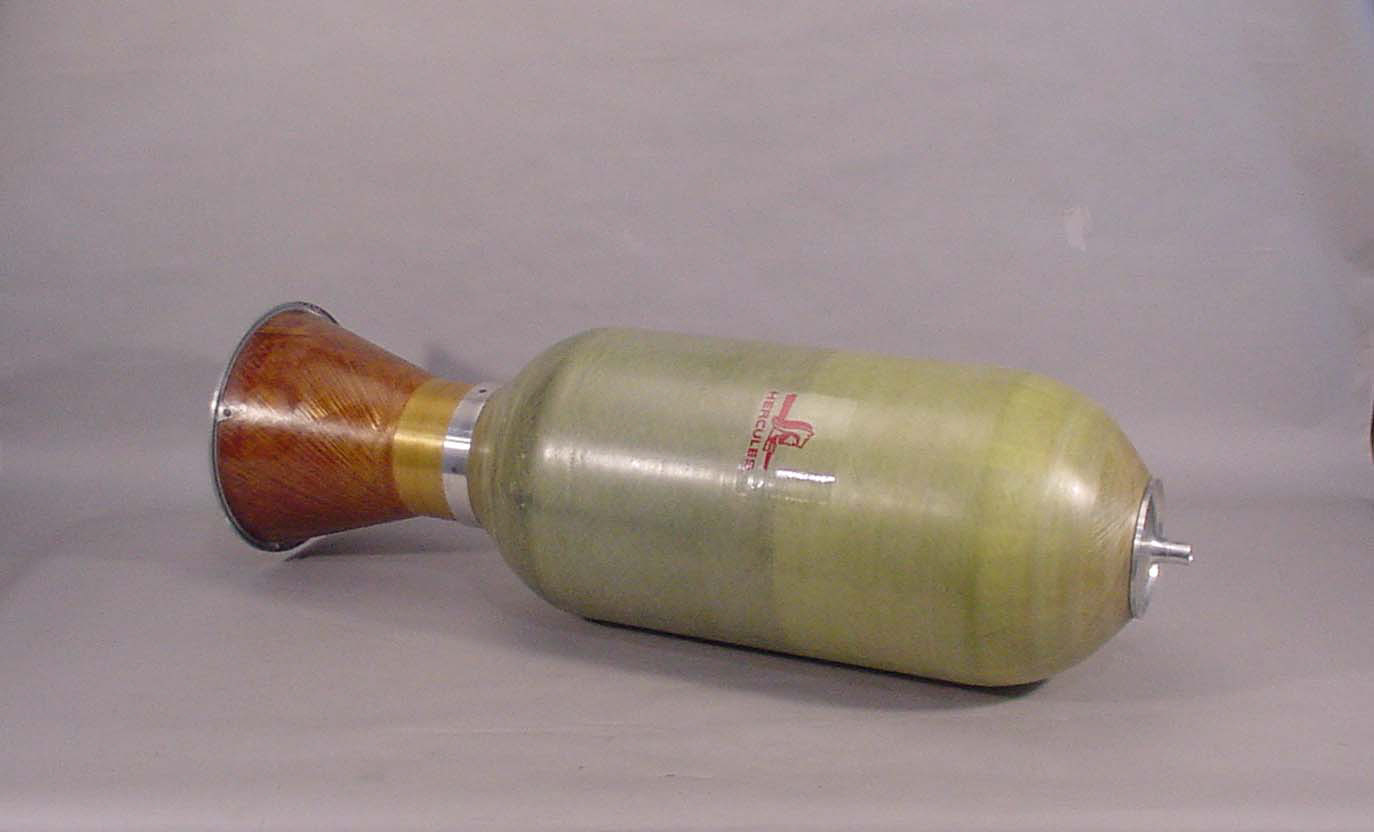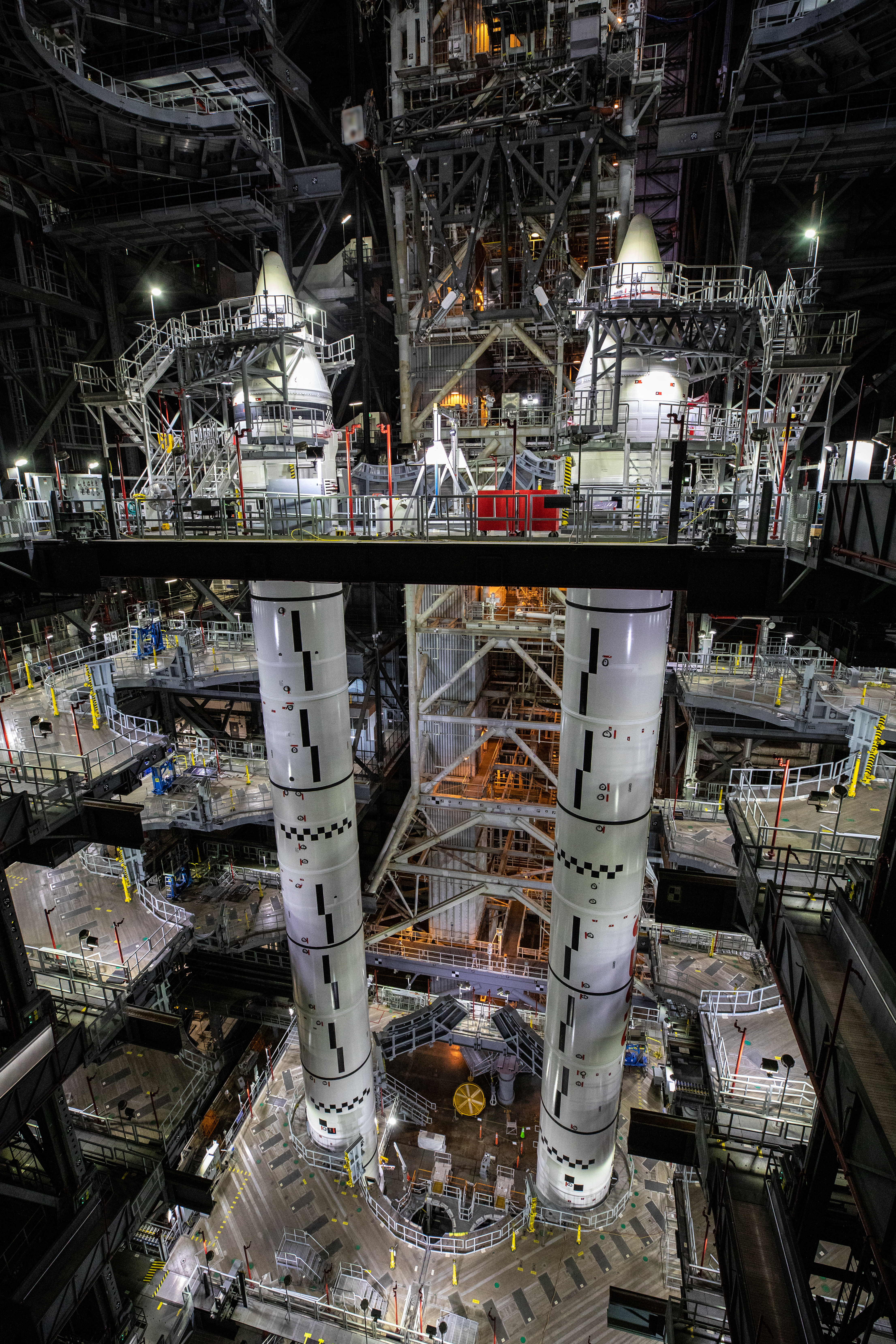|
Delta E
The Delta E, or Thor-Delta E was an American expendable launch system used for twenty-three orbital launches between 1965 and 1971. It was a member of the Delta family of rockets. The first stage was a Thor missile in the DSV-2C configuration, and the second stage was the Delta-E, which was derived from the earlier Delta-A. Three Castor-1 solid rocket boosters were clustered around the first stage. Two different solid-fuel upper stages were available; an Altair-2 was used on the baseline version, however this could be replaced with an FW-4D to increase performance. A Delta E with the FW-4D upper stage was designated Delta E1. Six flights used the Delta E configuration and seventeen used the Delta E1. Delta E rockets were launched from Cape Canaveral Air Force Station Launch Complex 17 and Vandenberg Air Force Base Space Launch Complex 2E. All 23 flights were successful. On December 16 1965, a Delta E launched the Pioneer 6 space probe Uncrewed spacecraft or robot ... [...More Info...] [...Related Items...] OR: [Wikipedia] [Google] [Baidu] |
Pioneer 6
''Pioneer 6'', ''7'', ''8'', and ''9'' were unmanned space mission, space probes in the Pioneer program, launched between 1965 and 1969. They were a series of solar-orbiting, spin-stabilized, solar cell- and battery-powered satellites designed to obtain measurements on a continuing basis of interplanetary phenomena from widely separated points in space. They were also known as Pioneer A, B, C, and D. The fifth (Pioneer E) was lost in a launch accident, and therefore did not receive a numerical designation. Purpose ''Pioneers 6'', ''7'', ''8'', and ''9'' were created to make the first detailed, comprehensive measurements of the solar wind, solar magnetic field and cosmic rays. They were designed to measure large scale magnetic phenomena and particles and fields in interplanetary space. Data from the vehicles have been used to better understand stellar processes and the structure and flow of the solar wind. The vehicles also acted as the world's first space-based solar weather n ... [...More Info...] [...Related Items...] OR: [Wikipedia] [Google] [Baidu] |
Thor DSV-2
The Thor DSV-2 was a series of sounding rockets, test vehicles, and anti-satellite weapons derived from the PGM-17 Thor, Thor Intermediate-range ballistic missile. It was also used as the first stage of several Thor (rocket family), Thor-derived expendable launch systems. Variants Thor DSV-2A The DSV-2A was a two-stage rocket, consisting of a DSV-2A / MB-3-II first stage, and an Able-Star / AJ10-104D second stage. It was launched eight times between 1963 and 1965 from Vandenberg Space Force Base, Vandenberg. Thor DSV-2D The DSV-2D was launched twice in 1962, conducting suborbital research flights for the development of the Program 437 ASAT. It was a single-stage vehicle, consisting of a Thor DM-21. Launches were conducted from Cape Canaveral Air Force Station Cape Canaveral Air Force Station Launch Complex 17, Launch Complex 17A. Thor DSV-2E The DSV-2E was a single-stage vehicle, using a Thor DM-19. It was launched eight times in 1962, including several nuclear weapons test ... [...More Info...] [...Related Items...] OR: [Wikipedia] [Google] [Baidu] |
Pioneer 6, 7, 8, And 9
''Pioneer 6'', ''7'', ''8'', and ''9'' were space probes in the Pioneer program, launched between 1965 and 1969. They were a series of solar-orbiting, spin-stabilized, solar cell- and battery-powered satellites designed to obtain measurements on a continuing basis of interplanetary phenomena from widely separated points in space. They were also known as Pioneer A, B, C, and D. The fifth (Pioneer E) was lost in a launch accident, and therefore did not receive a numerical designation. Purpose ''Pioneers 6'', ''7'', ''8'', and ''9'' were created to make the first detailed, comprehensive measurements of the solar wind, solar magnetic field and cosmic rays. They were designed to measure large scale magnetic phenomena and particles and fields in interplanetary space. Data from the vehicles have been used to better understand stellar processes and the structure and flow of the solar wind. The vehicles also acted as the world's first space-based solar weather network, providing pract ... [...More Info...] [...Related Items...] OR: [Wikipedia] [Google] [Baidu] |
Altair (rocket Stage)
The Altair was a solid-fuel rocket with a fiberglass casing, initially developed for use as the multistage rocket, third stage of Vanguard rockets in 1959. It was manufactured by Allegany Ballistics Laboratory (ABL) as the X-248. It was also sometimes called the Burner (rocket stage), Burner 1. Altair The X-248 was one of two third-stage designs used during Project Vanguard. Early launches used a stage developed by the Lockheed Propulsion Company, Grand Central Rocket Company, but the last used the X-248 which enabled the Vanguard to launch more massive payload. The X-248 was used as the second stage of some early Thor (rocket family), Thor flights. These vehicles were designated "Thor-Burner". Altairs were used as the third stage of early Delta rockets. The fourth stage of the Scout X-1, Scout-X rocket used the "Altair-1A" stage, powered by a X-248A engine. Altair 2 The Altair 2 (X-258) Thiokol (Star (rocket stage), Star 25, TE-M-184-3) solid rocket engine first flew in 196 ... [...More Info...] [...Related Items...] OR: [Wikipedia] [Google] [Baidu] |
Solid Rocket
A solid-propellant rocket or solid rocket is a rocket with a rocket engine that uses solid propellants (fuel/ oxidizer). The earliest rockets were solid-fuel rockets powered by gunpowder. The inception of gunpowder rockets in warfare can be credited to the ancient Chinese, and in the 13th century, the Mongols played a pivotal role in facilitating their westward adoption. All rockets used some form of solid or powdered propellant until the 20th century, when liquid-propellant rockets offered more efficient and controllable alternatives. Because of their simplicity and reliability, solid rockets are still used today in military armaments worldwide, model rockets, solid rocket boosters and on larger applications. Since solid-fuel rockets can remain in storage for an extended period without much propellant degradation, and since they almost always launch reliably, they have been frequently used in military applications such as missiles. The lower performance of solid propellants ... [...More Info...] [...Related Items...] OR: [Wikipedia] [Google] [Baidu] |
Solid Rocket Booster
A solid rocket booster (SRB) is a solid propellant motor used to provide thrust in spacecraft launches from initial launch through the first ascent. Many launch vehicles, including the Atlas V, SLS and Space Shuttle, have used SRBs to give launch vehicles much of the thrust required to place the vehicle into orbit. The Space Shuttle used two Space Shuttle SRBs, which were the largest solid propellant motors ever built until the Space Launch System and the first designed for recovery and reuse. The propellant for each solid rocket motor on the Space Shuttle weighed approximately 500,000 kilograms.. Advantages Compared to liquid propellant rockets, the solid-propellant motors (SRMs) have been capable of providing large amounts of thrust with a relatively simple design. They provide greater thrust without significant refrigeration and insulation requirements, and produce large amounts of thrust for their size. Adding detachable SRBs to a vehicle also powered by liquid-propel ... [...More Info...] [...Related Items...] OR: [Wikipedia] [Google] [Baidu] |
Castor (rocket Stage)
Castor is a family of solid-fuel rocket stages and boosters built by Thiokol (now Northrop Grumman) and used on a variety of launch vehicles. They were initially developed as the second-stage motor of the Scout rocket. The design was based on the MGM-29 Sergeant, a surface-to-surface missile developed for the United States Army at the Jet Propulsion Laboratory. Versions Flown versions Castor 1 :The Castor 1 was first used for a successful suborbital launch of a Scout X-1 rocket on September 2, 1960. :It was long, in diameter, and had a burn time of 27 seconds. Castor 1 stages were also used as strap-on boosters for launch vehicles using Thor first stages, including the Delta D. (A Delta-D was used in 1964 to launch Syncom-3, the first satellite placed in a geostationary orbit.) Castor 1 stages were used in 141 launch attempts of Scout and Delta rockets, only 2 of which were failures. They were also used on some thrust-assisted Thor-Agena launchers. The last launch us ... [...More Info...] [...Related Items...] OR: [Wikipedia] [Google] [Baidu] |
Delta A
The Delta A, or Thor-Delta A was an American expendable launch system used to launch two Explorer spacecraft in October 1962. A derivative of the Thor-Delta, it was a member of the Delta family of launch vehicles. The Thor-Delta itself was a Thor booster with an Able second stage and Altair third stage. The first stage was a Thor Thor (from ) is a prominent list of thunder gods, god in Germanic paganism. In Norse mythology, he is a hammer-wielding æsir, god associated with lightning, thunder, storms, sacred trees and groves in Germanic paganism and mythology, sacred g ... missile in the DM-21 configuration, and the second stage was thDelta-A an uprated version of the original Delta (rocket stage), Delta. An Altair (rocket stage), Altair Solid-propellant rocket, solid rocket motor was used as a third stage. Both launches occurred from Cape Canaveral Space Force Station, Cape Canaveral Air Force Station (CCAFS) Cape Canaveral Launch Complex 17, Launch Complex 17B, and were ... [...More Info...] [...Related Items...] OR: [Wikipedia] [Google] [Baidu] |






